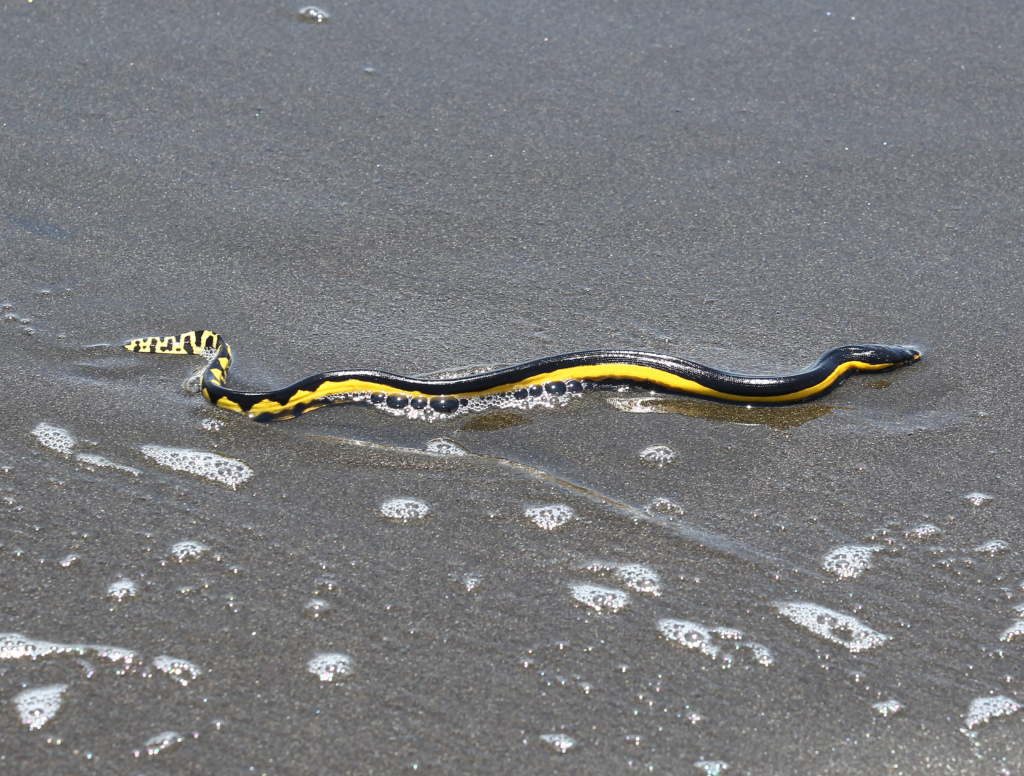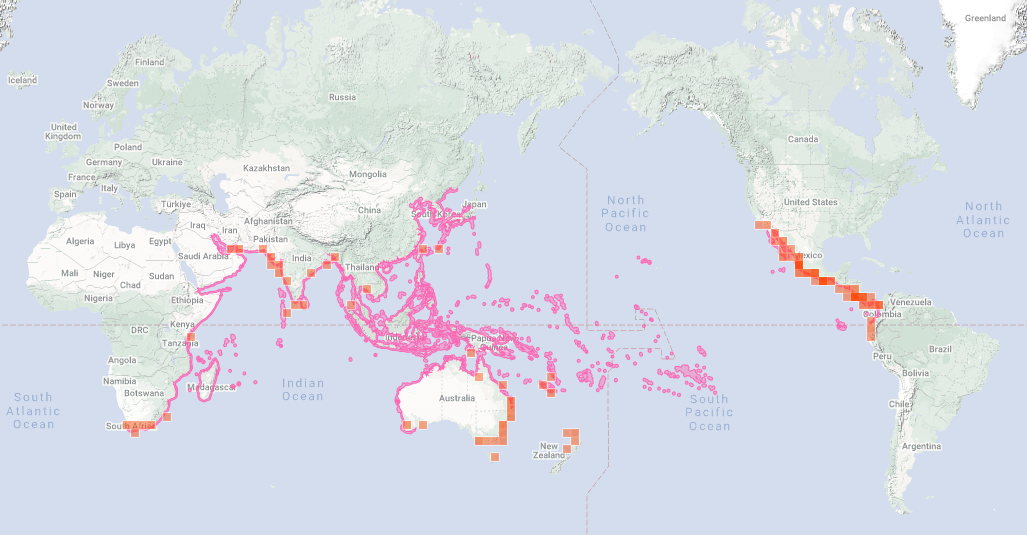The Yellow-bellied Sea Snake
Hydrophis platura
Description:
Described in 1766, the Yellow-bellied Sea Snake is brown or black above, with a yellow underneath that extends about half-way up the sides. The paddle-shaped tail is yellow with black bars or blotches. There is an all-yellow form that occurs in the gulf at Golfo Dulce, Costa Rica. The head is narrow, wedge-shaped, slightly flattened and moderately distinct from the neck. The body is laterally compressed and the tail is blunt and shaped like an oval paddle. The average sized adult Yellow-bellied sea snake is around 70cm, with large specimens reaching up to 90cm.
Habitat:
This snake is found in tropical or warm waters and lives anywhere from close to the shore or deeper ocean. It is seldom seen but known to congregate around floating mats of dead kelp, seaweed, wood and debris. Sometimes it can be seen out at sea, drifting on the surface currents, usually with its head pointing down.
Biology and Habits:
The Yellow-bellied sea snake is fully adapted to life in the ocean where is hunts, mates and reproduces. It struggles to move on land due to its narrow ventrals and compressed shape. Beached specimens are usually in a bad state of health, either dead or dying.
Breeding can take place year-round if the water temperatures are warm enough. Up to 10 babies are born after a gestation period of 6 to 8 months.
Even though they live in the ocean, sea snakes need to drink fresh water. In times of heavy rains they will drink freshwater that accumulates on the surface of the ocean. Yellow-bellied Sea Snakes are known to live in a state of dehydration during dry seasons, rehydrating in rainy seasons.
Yellow-bellied sea snakes are “float-and-wait” hunters. They often float with the head angled down, catching fish that come nearby. Additionally, unlucky fish may mistakenly seek shelter under the floating snake, and these fish get snapped up quickly. It is thought that the eyesight of this snake is poor, and it ‘senses’ fish vibrations using small sensory organs located around their mouth. When a fish is detected, and in close range, the sea snake will strike, often sideways, to capture and then rapidly consume the fish.
Sea snakes are able to swim forwards and backwards using an undulating (wavy) movement. Aside from floating motionless on the surface, sea snakes will often dive down, spending up to 50% of their lives underwater. It is thought that diving down helps the snakes: regulate their body temperature, avoid predators, escape sea surface turbulence, and possibly seek out other surface kelp-mats or drift-lines. They will dive to depths of around 15m but can go deeper, up to 50m recorded. Sea snakes can stay submerged for up to 24 hours, but dives usually only last a few hours.
Yellow-bellied sea snakes have semi-permeable skin which extracts oxygen from the water at rates of up to 33% of its total oxygen uptake, and emits carbon dioxide and rates of up to 94% of total oxygen consumption.
This form of ‘aquatic’ respiration assists the snake in prolonging its diving time by providing supplemental oxygen and averting respiratory acidosis through the release of carbon dioxide. This also provides a platform for the balancing of inert gases to prevent decompression syndrome.
Yellow-bellied sea snakes are known to accumulate aquatic organisms and invertebrates on their skin – these include snails, barnacles and other biota. They are sometimes colonised by tiny fish, shrimps and crabs. To get rid of accumulated organisms, and aid in shedding the skin, the sea snake will engage in spontaneous ‘knotting’ behaviour, knotting, twisting and coiling against itself, sometimes for prolonged periods.
Danger and Venom:
Although the Yellow-bellied Sea Snake has deadly neurotoxic venom, bites and deaths are rare. These snakes are reluctant to bite, when in water. In known bites, symptoms are typical of those caused by neurotoxic venom, and include progressive weakness and muscle paralysis that can lead to respiratory failure.
Antivenom is not produced or available in South Africa. There is a general sea snake antivenom made in Australia, where sea-snakes are common. This antivenom is made from the venom of the beaked sea snake Hydrophis schistosus, and it will neutralise the venom of the Yellow-bellied sea snake. This antivenom is produced by Commonwealth Serum Laboratories Ltd (of Melbourne, Australia).
Distribution:
The Yellow-bellied Sea Snake is considered the most widespread species of snake in the world. Absent only from the Atlantic Ocean, it is found in warmer tropical and sub-tropical waters spanning almost the entire Indian and Pacific Oceans. From southern California south to the western coasts of Central and South America, then all across the Pacific Ocean, through Hawaii to the Sea of Japan (There is one record off the coast of Russia – Kharin, Vladimir E. 2007). The distribution continues south through Indonesia, all around Australia and New Zealand, up across to India, Pakistan, through the Arabian Sea and down along the entire eastern coast of Africa to Cape Town. It ranges across all tropical Indian Ocean islands, including Madagascar.
In South Africa this snake is rarely seen. When sightings do occur, they are usually snakes washed up on beaches along the Eastern Cape coast around East London and Port Elizabeth, with scattered records on the southern coast of the Western Cape including Mossel Bay region and the False Bay area of Cape Town. Although infrequently seen in Kwazulu-Natal, there is a recent record form Umhlanga, north of Durban.
In some regions they can be quite common, like the Pacific coastal waters off Costa Rica and parts of Mexico including Baja California. They are also relatively often washed up on Australian beaches.
A map from iNaturalist showing the extensive range of the Yellow-bellied Sea Snake in pink, and public observations indicated by red squares.



